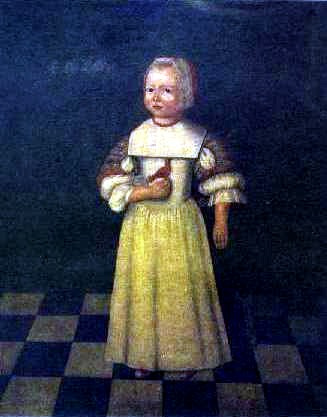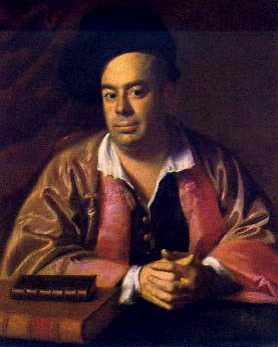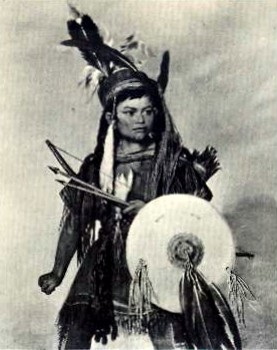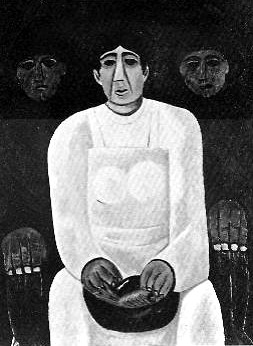|
Easily the Better Living
Center's signature exhibit of "high culture," this
third floor exhibition featured forty-one paintings and five
works of sculpture by some of America's most famous artists from
the 17th century to the present. Sponsored by Maine's Skowhegan
School of Painting and Sculpture it represented an attempt, as
the exhibit's guidebook noted, to show how "the aspects
of a changing America are recorded by artists whose accents and
manners vary, but whose vision of the truth is steady."
This unifying structure, the exhibitors argued, could be seen
in works as diverse as an 18th century Gilbert Stuart portrait
and a 20th century Jackson Pollock "action painting."
The exhibition was one
of the few art exhibits and displays at the Fair to earn praise
from the New York Times' art critic, John Canaday. He described
"Four Centuries of American Masterpieces" as "closer
to being a summary than you would think so small a show could
be," and that the works had been "selected with such
discernment that this minor exhibition becomes a major pleasure."
Canaday's lone complaint? The fact that in order to see the exhibition,
one had to follow the proscribed path of seeing the "entire"
Better Living Center. But even if the route hadn't been forced
upon visitors, it still offended Canaday's sense of esthetics
to see such an exhibit in close proximity to displays from Hershey
Chocolate, Borden, Sunshine Biscuits and a nine-hole miniature
golf course. "They are worth seeing, but to get there, and
out again, without suffering spiritual and esthetic offense on
the way, is impossible." Because of the Fair's general surroundings,
Canaday was of the opinion that art exhibitions in general, even
good ones like "Four Centuries," amounted to a waste
of time because the proper way to appreciate good art would not
be there.
Perhaps it was out of the
ordinary to see such an impressive display of American art in
close proximity to a musical revue show about a cow. But in the
end, that only served to demonstrate the very nature of what
the Better Living Center was all about. A pavilion that represented
diversity in its truest sense.
|
History in Portraits
|
Gilbert Stuart tartly maintained that "no one would paint
history who could do a portrait," but as the chief depicter
of George Washington, he showed that to paint portraits is often
to paint great history. Over the centuries, on a less exalted
plane, an amazing amount of homely personal history also stuck
to the brushes of the portrait painters, but the daguerreotype
and the photograph in the end reduced this broad popular stream
of American art to a trickle. The rise and decline of portraiture
is the most striking theme of a World's Fair exhibit called "Four
Centuries of American Masterpieces" and housed in the Better
Living Center.
More Doll Than Boy. The first New World painters called themselves
artisans and drew picture signs for taverns, or coated fire buckets,
depending on the state of business. In that stern and frugal
age, a commission for a portrait was a plum. "Limning"
a portrait meant producing a flat two-dimensional likeness, and
what what gives tang to these works now is the period flavor
and not any sureness of craft or conviction of life. Primitive,
untutored and serene, the anonymous 1670 Portrait of Henry Gibbs
is a charming example of the limner's style.
|
Portrait Of Henry Gibbs (1670)
 |
|
The floor is in perspective; little Henry is not. More girl
than boy, more doll than either, the child seems to be floating
through the picture, not rooted in it. Yet the boy's and the
painting's mood of grave, graceful self-possession is undiminished
after nearly three centuries. In time, the limners became the
itinerant painters who criss-crossed the continent by foot, horseback
and wagon well into the 19th century, painting family portraits
in return for food and temporary lodging.
Artists of loftier vocation expatriated themselves to study
in England and to absorb the classic mastery of Renaissance portraiture.
John Singleton Copley was one such, but before he left U.S. shores,
he had already put together a masterly portrait gallery of some
of his fellow Bostonians. His Portrait of Nathaniel Hard, a famed
silversmith and engraver, stares back at the observer with a
keen, curious, probing intensity that is uncannily lifelike.
As John Adams said of Copley's portraits: "You can scarcely
help discoursing with them, asking questions and receiving answers."
|
Portrait Of Nathaniel Hard (c. 1765-1770)
 |
|
Bravado & Bravery. The idea that portraits were history came
naturally to Western Painter George Catlin. In the 1830s he resolved
to assemble a pictorial record of the last golden years of the
Indians freely living their own lives. He rode across hundreds
of miles of unmapped prairie, visited 48 tribes and painted 600
pictures. His Indian Boy is a triumph of photographic realism
blended with psychological insight. There is a trace of bravado
in the boy's stance, backed by ultimate bravery in the clenched
right fist. Around the eyes and mouth is the faint hint of sadness
of a boy fated never to roam and rule the land of his father. |
Indian Boy (1835)
 |
|
The mask of anguish in Marsden Hartley's The Lost Felice hides
a different sort of grief. It is a symbol of womanhood mourning
her drowned sons. The 20th century's passion for abstraction
makes any representational figure seem accessibly human, but
the grieving mother in Hartley's picture resembles a woman only
in the way that an eerie echo resembles a voice. The intentional
distortions of the 1939 picture ironically complete the cycle
begun with the unintentional distortions of the 1670 picture.
Perhaps fittingly, the decline of portraiture ends without a
portrait |
Lost Felice (1939)
 |
-
Jackson Pollock (1912-1956)
-
-
Arabesque, 1948
-
Oil on canvas, 37 x 117
-
Coll. Richard Brown Baker
 |
SOURCE: Souvenir
Guidebook, Four Centuries of American Masterpieces |